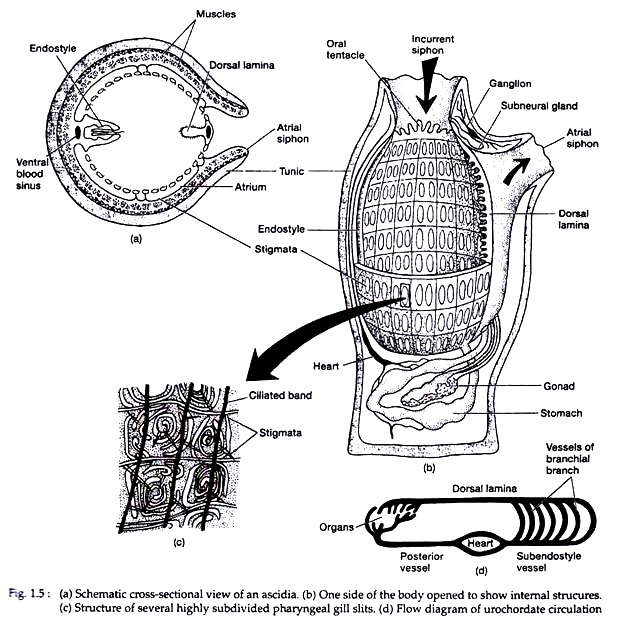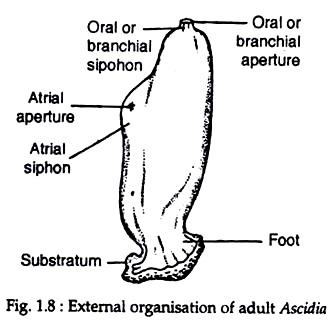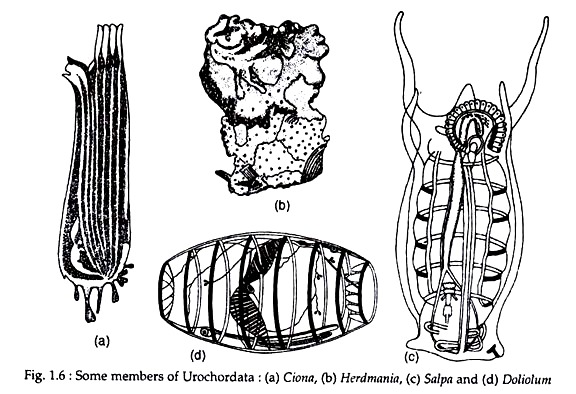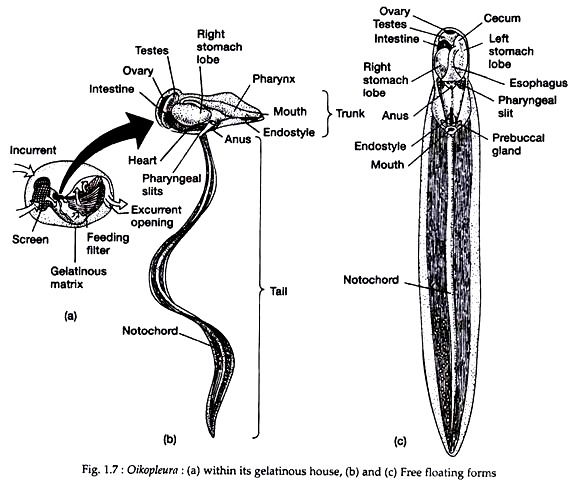In this article we will discuss about the characters and classification of urochordata.
Characters of Urochordata:
These animals are known as ‘sea squirt’. The life-history of urochordates passes through a dramatic change. Their chordate characters are more pronounced during larval period. While in adults they are more like invertebrates than chordates. Therefore, the characters are described in two heads — larval characters (Fig. 1.4) and adult characters (Fig. 1.5).
Larval characters of Urochordates:
ADVERTISEMENTS:
1. Elongated larva of Urochordata is known as ascidian tadpole larva. Adult emerges from the larva by the process of metamorphosis.
2. Notochord restricted at the caudal end, hence name Urochordata.
3. Dorsal hollow nerve chord spreads end to end.
ADVERTISEMENTS:
4. Pharyngeal gill slits are present.
5. Highly active post anal tail is prominent.
Adult characters of Urochordata:
1. The body of the adult is covered by a tunic (hence named Tunicata). The tunic is composed of a protein tunicin and a polysaccharide similar to plant cellulose.
ADVERTISEMENTS:
2. Adults are sessile and attached to the substratum of the sea.
3. Incurrent branchial siphon, and ex-current atrial siphon, form entrance and exit portals for the water that circulates through the body.
4. Branchial siphon opens into a branchial basket, i.e. pharynx.
5. Tiny finger-like sensory tentacles encircle the incurrent siphon to examine the incoming water and prevent large particles from entering.
6. These are hermaphrodite animals; reproduce both sexually and asexually.
Classification of Urochordata:
This subphylum is divided into three classes — Ascidiacea, Thaliacea and Larvacea.
The characters and examples of these classes are given here:
A. Class — Ascidiacea:
ADVERTISEMENTS:
General characters:
1. Comprises mostly brightly coloured marine animals.
2. Some species are solitary, others are colonial.
3. Adults are sessile, but larvae are plank
tonic and do not feed.
4. Adults having sac-like body, covered by tunic.
5. Most of the chordate characters that were present during larval period disappear during metamorphosis into adult.
6. In adult, nervous system transforms into a nerve ganglion.
Examples:
Ascidia (Fig. 1.8), Ciona (Fig. 1.6a), Herdmania (Fig. 1.6b).
B. Class — Thaliacea:
General Characters:
1. These are free-living pelagic urochordates.
2. The tunic is transparent and thin.
3. They possess encircling circumferential bands of muscles within the walls of the test.
4. Incurrent and ex-current siphons are present at opposite end of the body.
5. A few pharyngeal gill slits are present.
6. In the life-cycle polymorphism and clear alternation of generations are evident.
Examples:
Salpa (Fig. 1.6c), Doliolum (Fig. 1.6d).
C. Class — Larvacea/Appendicularia:
General characters:
1. These are tiny marine planktonic urochordates found worldwide.
2. Larvacea received their name because the adults retain larval characteristics similar in some way to the ascidian tadpole with its tail and trunk. The general resemblance of adult larvaceans to ascidian tadpoles suggests that larvaceans may be neotenous form.
3. They produce a remarkable feeding apparatus (house) that consists of three components: screens, filters and expanded gelatinous matrix. Disturbed or actively feeding larvaceans abandon their old house and builds a new one.
4. The trunk holds major body organs.
5. The tail is thin and flat.
6. Muscle bands act on notochord to produce movement.
7. A tubular nerve cord is present.
8. All species, except one, are monoecious, and most of these are protandrous.
Examples:
Oikopleura (Fig. 1.7), Appendicularia.




